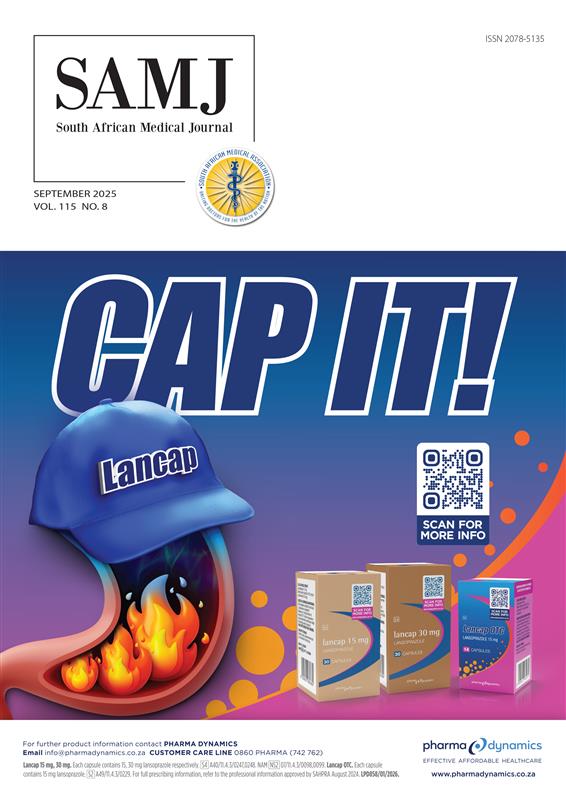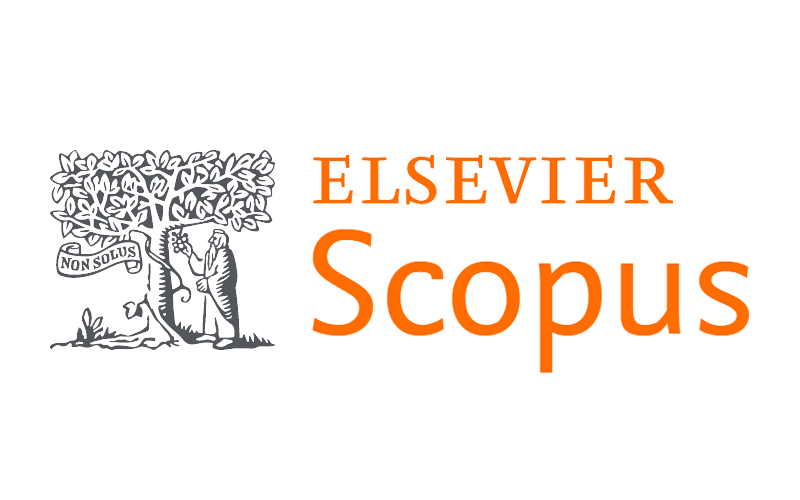The Use of venous thromboembolism prophylaxis in relatioN to patiEnt risk profilINg (TUNE IN) Wave 3 study
DOI:
https://doi.org/10.7196/SAMJ.2025.v115i8.3111Keywords:
venous thromboembolism, thromboprophylaxis, medical inpatients, surgical inpatientsAbstract
Background. Thromboprophylaxis significantly reduces the risk of venous thromboembolism (VTE) in hospitalised medical and surgical patients. Nonetheless, the implementation of thromboprophylaxis in South Africa (SA) and worldwide is low.
Objective. The TUNE-IN (The Use of venous thromboembolism prophylaxis in relatioN to patiEnt risk profilINg) Wave 3 study is an extension of TUNE-IN Wave 1 and 2. This prospective, cross-sectional study assessed the use of VTE thromboprophylaxis in hospitalised medical, surgical and orthopaedic patients.
Methods. Over a 9-month period, 451 consenting patients >18 years of age hospitalised at Charlotte Maxeke Johannesburg Academic Hospital in Gauteng, SA, were systematically included. Patients were assessed and risk stratified according to the IMPROVE (International Medical Prevention Registry on Venous Thromboembolism) bleeding risk and Caprini risk assessment tools. Data on the use of VTE thromboprophylaxis, agent and dose were collected from the hospital records.
Results. The study identified 180 (40%) medical, 198 (44%) surgical and 73 (16%) orthopaedic participants. VTE thromboprophylaxis was administered in 263 (58%) study participants. In accordance with the American College of Chest Physicians guidelines on VTE prevention, adequate thromboprophylaxis was administered in 233 (52%). The most common thromboprophylaxis agent was low molecular weight heparin. Subsequently, the Caprini risk assessment tool identified 337 participants (75%) with a VTE risk score >2, whereas the IMPROVE risk assessment tool identified 22 participants (5%) with a high bleeding risk score (≥7). In accordance with the risk assessment tools, recommended thromboprophylaxis was administered in 68% of medical, 59% of surgical and 79% of orthopaedic high-risk participants (p<0.012). The proportion of medical and surgical participants at high VTE risk was similar to that in the Wave 1 and/or 2 studies; however, the rates of VTE thromboprophylaxis in the present study were lower (p=0.097 for medical and p<0.001 for surgical participants).
Conclusion. This study shows a significant gap between evidence-based thromboprophylaxis recommendations and clinical practice in a large sample of hospitalised medical, surgical and orthopaedic participants. It is recommended that an institutional VTE risk assessment tool be implemented to standardise risk evaluation and improve the administration of appropriate thromboprophylaxis for hospitalised patients.
References
1. Heit JA, Melton LJ, Lohse CM, et al. Incidence of venous thromboembolism in hospitalised patients vs community residents. Mayo Clin Proc 2001;76(11):1102-1110. https://doi.org/10.4065/76.11
2. C Danwang, Temgoua MN, Agbor VN, et al. Epidemiology of venous thromboembolism in Africa: A systematic review. J Thrombosis Haemostasis 2017;15(9):1770-1781. https://doi.org/10.1111/ jth.13769Jacobson BF, Louw S, Mer M, et al. Venous thromboembolism – prophylactic and therapeutic practice guideline. S Afr Med J 2009;99(99):467-473
3. Anderson DR, Morgano GP, Bennett C, et al. American Society of Hematology 2019 guidelines for management of venous thromboembolism: Prevention of venous thromboembolism in surgical hospitalised patients. Blood Adv 2019;3(23):3898-3944. https://doi.org/10.1182/ bloodadvances.2019000975
4. Neumann I, Izcovich A, Aguilar R, et al. American Society of Hematology, ABHH, ACHO, Grupo CAHT, GrupoCLAHT, SAH, SBHH, SHU, SOCHIHEM, SOMETH, Sociedad Panameña de Hematología2022 guidelines for prevention of venous thromboembolism in surgical and medical patients and long-distance travelers in Latin America. Blood Adv 2022;6(12):3636-3649. https://doi. org/10.1182/bloodadvances.2021006482
5. Kearon C, Akl EA, Comerota AJ, et al. Antithrombotic therapy for VTE disease. Chest 2012;141(2Suppl):e419S-e496S. https://doi.org/10.1378/chest.11-2301
6. Stevens SM, Woller SC, Baumann Kreuziger L, et al. Executive summary. Antithrombotict Therapy for VTE disease: Second update of the CHEST guideline and expert panel report. Chest 2021;160(6):2247- 2259. https://doi.org/10.1016/j.chest.2021.07.056
7. Caprini JA. Thrombosis risk assessment as a guide to quality patient care. Disease-a-Month 2005;51(2-3):70-78. https://doi.org/10.1016/j.disamonth.2005.02.003
8. Pandor A, Tonkins M, Goodacre S, et al. Risk assessment models for venous thromboembolism in hospitalised adult patients: A systematic review. BMJ Open 2021;11(7):e045672. https://doi.org/10.1136/ bmjopen-2020-045672
9. Cohen AT, Tapson VF, Bergmann J-F, et al. Venous thromboembolism risk and prophylaxis in the acute hospital care setting (ENDORSE study): A multinational cross-sectional study. Lancet 2008;371(9610):387-394. https://doi.org/10.1016/S0140-6736(08)60202-0
10. Tapson VF, Decousus H, Pini M, et al. IMPROVE investigators venous thromboembolism prophylaxis in acutely ill hospitalised medical patients: Findings from the international medical prevention registry on venous thromboembolism. Chest 2007;132(3):936-945. https://doi.org/10.1378/chest.06-2993
11. Riback WJ, Wessels P. The Use of DVT prophylaxis in relation to patient risk profiling – TUNE-IN Study. S Afr Med J 2012;102(2):85. https://doi.org/10.7196/SAMJ.4859
12. Jacobson BF, Louw S, Riback W. The Use of VTE prophylaxis in relatioN to patiEnt risk profiling (TUNE-IN) Wave 2 study. S Afr Med J 2014;104(12):880. https://doi.org/10.7196/SAMJ.8456
13. Wei Q, Sun J, Bai Y, et al. Aspirin versus LMWH for VTE prophylaxis after orthopedic surgery. Open Med 2023;18(1):20230760. https://doi.org/10.1515/med-2023-0760
14. Moolman C, du Plessis M, Venter C, et al. The adapted Caprini score as a proxy for postoperative venous thromboembolism prophylaxis: A tertiary hospital experience. S Afr J Surg 2024;62(4):327- 332. https://doi.org/10.36303/SAJS.00171
15. Cronin M, Dengler N, Krauss ES, et al. Completion of the updated Caprini risk assessment model (2013 version). Clin Applied Thrombosis/Hemostasis 2019;25:1076029619838052. https://doi. org/10.1177/1076029619838052
Downloads
Published
Issue
Section
License
Copyright (c) 2025 J Bassett, E Schapkaitz, B Jacobson

This work is licensed under a Creative Commons Attribution-NonCommercial 4.0 International License.
Licensing Information
The SAMJ is published under an Attribution-Non Commercial International Creative Commons Attribution (CC-BY-NC 4.0) License. Under this license, authors agree to make articles available to users, without permission or fees, for any lawful, non-commercial purpose. Users may read, copy, or re-use published content as long as the author and original place of publication are properly cited.
Exceptions to this license model is allowed for UKRI and research funded by organisations requiring that research be published open-access without embargo, under a CC-BY licence. As per the journals archiving policy, authors are permitted to self-archive the author-accepted manuscript (AAM) in a repository.
Publishing Rights
Authors grant the Publisher the exclusive right to publish, display, reproduce and/or distribute the Work in print and electronic format and in any medium known or hereafter developed, including for commercial use. The Author also agrees that the Publisher may retain in print or electronic format more than one copy of the Work for the purpose of preservation, security and back-up.





